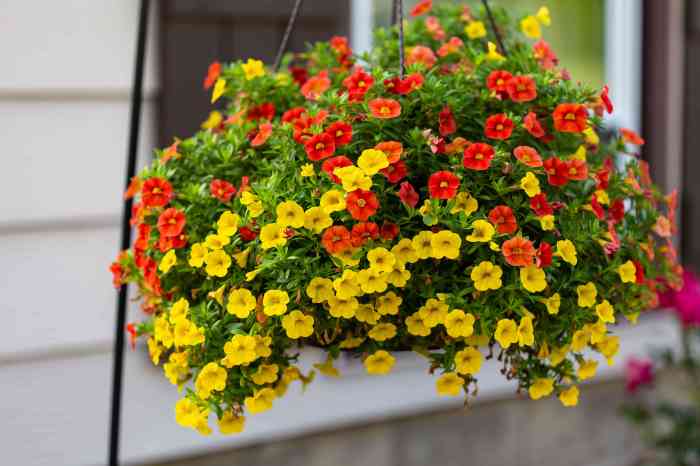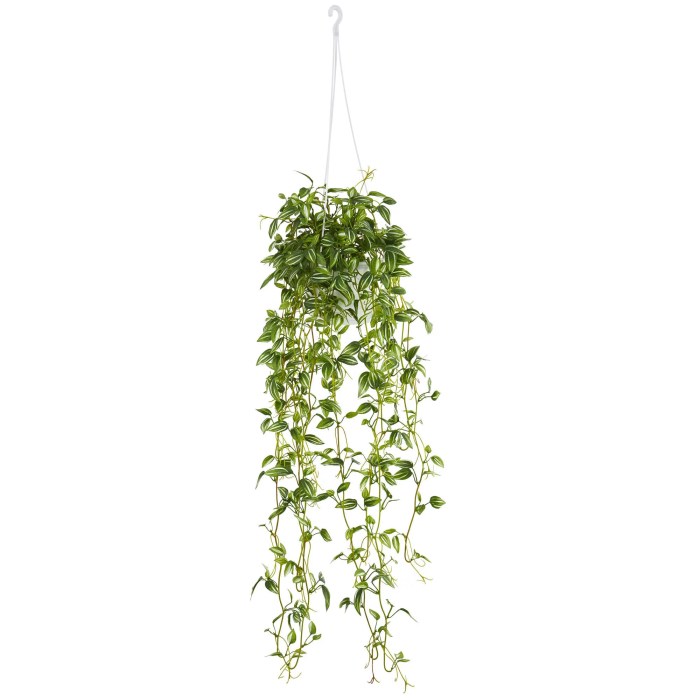Dive into the world of 10 hanging plants name, a captivating guide that unveils the wonders of these enchanting plants. Discover their unique characteristics, care requirements, and the transformative power they bring to any space.
Hanging plants have emerged as a beloved choice for plant enthusiasts, offering a myriad of benefits that extend beyond their aesthetic appeal. They not only purify the air, reducing stress levels, but also add a touch of elegance and vibrancy to any room.
Popular Hanging Plants: 10 Hanging Plants Name

Hanging plants add a touch of greenery and freshness to any space. They can be used to create vertical gardens, add height to a room, or simply brighten up a corner. There are many different types of hanging plants to choose from, each with its own unique characteristics and care requirements.Here
are 10 of the most popular hanging plants:
Spider Plant
- Scientific name: Chlorophytum comosum
- Description: The spider plant is a popular hanging plant because it is easy to care for and produces long, trailing stems with baby plants at the ends.
- Care requirements: Spider plants prefer bright, indirect light and well-drained soil. They should be watered regularly, but allowed to dry out between waterings.
Pothos
- Scientific name: Epipremnum aureum
- Description: Pothos is another easy-to-care-for hanging plant that is known for its trailing vines and heart-shaped leaves.
- Care requirements: Pothos prefers bright, indirect light and well-drained soil. They can tolerate low light conditions, but may not grow as quickly.
String of Pearls
- Scientific name: Senecio rowleyanus
- Description: String of pearls is a unique hanging plant with long, trailing stems that are covered in small, bead-like leaves.
- Care requirements: String of pearls prefers bright, indirect light and well-drained soil. They should be watered sparingly, as they are prone to root rot.
Burro’s Tail
- Scientific name: Sedum morganianum
- Description: Burro’s tail is a succulent hanging plant with trailing stems that are covered in plump, teardrop-shaped leaves.
- Care requirements: Burro’s tail prefers bright, indirect light and well-drained soil. They should be watered sparingly, as they are prone to root rot.
Hoya
- Scientific name: Hoya carnosa
- Description: Hoya is a flowering hanging plant with thick, waxy leaves and clusters of star-shaped flowers.
- Care requirements: Hoya prefers bright, indirect light and well-drained soil. They should be watered sparingly, as they are prone to root rot.
Peperomia
- Scientific name: Peperomia obtusifolia
- Description: Peperomia is a small, compact hanging plant with thick, fleshy leaves.
- Care requirements: Peperomia prefers bright, indirect light and well-drained soil. They should be watered regularly, but allowed to dry out between waterings.
Tradescantia
- Scientific name: Tradescantia zebrina
- Description: Tradescantia is a trailing hanging plant with variegated leaves that come in a variety of colors.
- Care requirements: Tradescantia prefers bright, indirect light and well-drained soil. They can tolerate low light conditions, but may not grow as quickly.
Air Plant
- Scientific name: Tillandsia
- Description: Air plants are unique hanging plants that do not need soil to grow. They absorb nutrients from the air and water through their leaves.
- Care requirements: Air plants prefer bright, indirect light and high humidity. They should be misted regularly, but allowed to dry out between mistings.
Staghorn Fern
- Scientific name: Platycerium bifurcatum
- Description: Staghorn ferns are epiphytic plants that grow on trees in the wild. They have large, antler-shaped fronds that are covered in a velvety texture.
- Care requirements: Staghorn ferns prefer bright, indirect light and high humidity. They should be watered regularly, but allowed to dry out between waterings.
Prayer Plant
- Scientific name: Maranta leuconeura
- Description: Prayer plants are known for their colorful foliage and unique leaves that fold up at night, as if in prayer.
- Care requirements: Prayer plants prefer bright, indirect light and well-drained soil. They should be watered regularly, but allowed to dry out between waterings.
Hanging Plant Benefits

Hanging plants offer a myriad of benefits, enhancing both physical and mental well-being. They have the remarkable ability to improve air quality by absorbing pollutants and releasing oxygen, creating a healthier indoor environment.
Among the top 10 hanging plants name, many are suitable for indoor spaces, creating a vibrant and inviting atmosphere. Explore 10 hanging plants house options to add a touch of greenery to your living spaces. These plants offer not only aesthetic appeal but also air-purifying benefits, making them an excellent choice for healthy and beautiful homes.
Beyond air purification, hanging plants have been shown to reduce stress levels and promote relaxation. Their presence in a space can create a calming effect, reducing anxiety and improving overall mood. Additionally, they add a touch of greenery and visual interest to a room, enhancing the aesthetics and creating a more inviting atmosphere.
Enhancing Different Areas
Hanging plants can be strategically placed in various areas of a home or office to maximize their benefits. In living rooms, they can create a cozy and inviting ambiance, while in bedrooms, they can promote relaxation and restful sleep. In kitchens, they can help purify the air and add a touch of freshness, and in offices, they can reduce stress and improve productivity.
Hanging Plant Care
Hanging plants add a touch of greenery and freshness to any space, but they require proper care to thrive. Here’s a comprehensive guide to ensure your hanging plants stay healthy and vibrant.
Watering
The watering needs of hanging plants vary depending on the species, pot size, and environmental conditions. Generally, water your plants when the top inch of soil feels dry to the touch. Avoid overwatering, as it can lead to root rot.
Fertilizing
Fertilize your hanging plants regularly during the growing season (spring and summer) using a balanced liquid fertilizer. Follow the instructions on the fertilizer label for the recommended dilution ratio.
Pruning
Regular pruning helps maintain the shape and size of your hanging plants. Remove dead or damaged leaves and stems as needed. Pruning also encourages new growth and keeps your plants looking lush.
Troubleshooting Common Problems
- Yellowing Leaves:Yellowing leaves can indicate overwatering, underwatering, or nutrient deficiency. Check the soil moisture and fertilize your plants accordingly.
- Pests:Hanging plants can be susceptible to pests such as aphids, spider mites, and mealybugs. Use insecticidal soap or neem oil to control infestations.
Choosing the Right Pot and Hanger
The pot and hanger you choose for your hanging plants play a crucial role in their health and appearance. Choose a pot with drainage holes to prevent waterlogging. The hanger should be sturdy enough to support the weight of the plant and pot.
Hanging Plant Design

Hanging plants offer a unique and versatile way to add greenery and beauty to any space. They can be used to create vertical gardens, accent walls, and privacy screens, both indoors and outdoors.
Ten hanging plants name that will brighten up any room, including the bathroom. For a touch of greenery in your bathroom, consider these ten hanging plants that thrive in humid environments. Their cascading foliage and air-purifying qualities make them a great choice for adding life and freshness to your bathroom decor.
To learn more about these bathroom-friendly hanging plants, visit 10 hanging plants in bathroom for a detailed guide on their care and benefits.
When designing with hanging plants, there are a few things to keep in mind. First, consider the size and shape of the plants you choose. Larger plants will need more space, so be sure to choose a hanger that can accommodate them.
Second, think about the light conditions in the area where you’ll be hanging the plants. Some plants need more light than others, so be sure to choose plants that are suited to the light conditions in your space.
Vertical Gardens
Vertical gardens are a great way to add greenery to small spaces or to create a living wall. To create a vertical garden, simply hang a series of plants from the ceiling or wall. You can use a variety of different plants, including ferns, succulents, and herbs.
Accent Walls
Hanging plants can also be used to create accent walls. To do this, simply hang a series of plants in a vertical line on the wall. You can use a variety of different plants, including trailing plants, ferns, and succulents.
Privacy Screens
Hanging plants can also be used to create privacy screens. To do this, simply hang a series of plants in a row in front of a window or doorway. You can use a variety of different plants, including ferns, bamboo, and palms.
Combining Hanging Plants with Other Elements
Hanging plants can be combined with other elements to create unique and stylish displays. For example, you can hang plants in macrame hangers, terrariums, or on trellises. You can also use hanging plants to create living chandeliers or to decorate outdoor patios and balconies.
From spider plants to pothos, there are countless hanging plants that can add a touch of greenery to your home. If you’re looking for plants that are perfect for a hallway, check out our list of 10 hanging plants hallway . These plants are all easy to care for and will thrive in the low-light conditions of a hallway.
Plus, they’ll add a beautiful touch of nature to your home.
Unique Hanging Plants
Hanging plants offer a touch of elegance and freshness to any space. Beyond the popular varieties, there exists a realm of unique and lesser-known hanging plants that bring a distinct charm to your indoor garden. These plants showcase unusual growth habits, fascinating foliage, and specific care requirements, adding diversity and interest to your hanging plant collection.
Silver Satin Pothos
The Silver Satin Pothos ( Scindapsus pictus‘Exotica’) captivates with its velvety, silvery-green leaves adorned with intricate patterns. It prefers bright indirect light and moderate watering, thriving in humid environments. Its cascading vines make it an ideal choice for hanging baskets or trailing down shelves.
String of Dolphins
The String of Dolphins ( Senecio peregrinus) resembles a pod of tiny dolphins swimming through the air. Its plump, teardrop-shaped leaves are a vibrant green with distinctive markings. It requires ample sunlight and infrequent watering, making it a low-maintenance option. The String of Dolphins adds a whimsical touch to hanging pots or macrame hangers.
Burro’s Tail
The Burro’s Tail ( Sedum morganianum) resembles a miniature donkey’s tail with its trailing, fleshy stems. Its plump, blue-green leaves form a cascade of greenery that gracefully spills over the edges of hanging planters. It thrives in full sun to partial shade and prefers well-draining soil.
Lipstick Plant
The Lipstick Plant ( Aeschynanthus radicans) adds a vibrant pop of color to your hanging plant collection. Its glossy, dark green leaves contrast beautifully with its clusters of tubular flowers that resemble miniature lipsticks. It prefers bright indirect light and high humidity, making it a suitable choice for bathrooms or kitchens.
Chain of Hearts, 10 hanging plants name
The Chain of Hearts ( Ceropegia woodii) features delicate, heart-shaped leaves connected by thin, trailing stems. Its variegated foliage adds a touch of elegance to hanging planters or wall-mounted pots. It prefers bright indirect light and moderate watering, thriving in well-draining soil.
Outcome Summary
As we conclude our exploration of 10 hanging plants name, remember that these verdant wonders are not merely decorative pieces; they are living, breathing companions that bring life and tranquility to our surroundings. Embrace the joy of nurturing these plants, and let their beauty and benefits enrich your space for years to come.
Common Queries
What are the most popular hanging plants?
Pothos, Spider Plant, String of Pearls, Philodendron, and Hoya are some of the most popular hanging plants.
How often should I water my hanging plants?
Water your hanging plants when the soil feels dry to the touch. Avoid overwatering, as this can lead to root rot.
What are some creative ways to display hanging plants?
You can use macrame hangers, terrariums, or trellises to create unique and eye-catching displays for your hanging plants.